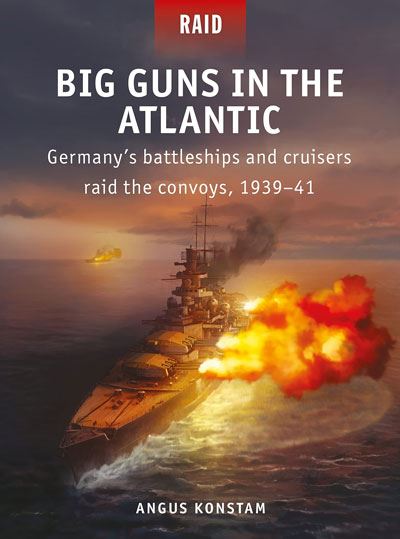Big Guns in the Atlantic: Germany’s battleships and cruisers raid the convoys, 1939-1941
Angus Konstam
 The defeat of Germany and the terms of peace imposed via the Treaty of Versailles in 1919 reduced its fleet to little more than a coast defense force capable of exerting little more than a degree of control within the Baltic. The Navy, however, had greater ambitions and realized its only viable strategy in the event of war with Britain was to strike against trade. Consequently, it developed and put into service warships capable of fulfilling this mission, epitomized by the powerful long-range panzerschiffe of the Deutschland class, the battleships of the Gneisenau class, and the Type VII and Type IX U-boats covertly designed in the Netherlands by the NV Ingenieurskantoor voor Scheepsbouw.
The defeat of Germany and the terms of peace imposed via the Treaty of Versailles in 1919 reduced its fleet to little more than a coast defense force capable of exerting little more than a degree of control within the Baltic. The Navy, however, had greater ambitions and realized its only viable strategy in the event of war with Britain was to strike against trade. Consequently, it developed and put into service warships capable of fulfilling this mission, epitomized by the powerful long-range panzerschiffe of the Deutschland class, the battleships of the Gneisenau class, and the Type VII and Type IX U-boats covertly designed in the Netherlands by the NV Ingenieurskantoor voor Scheepsbouw.
This paradigm held sway until the signing of the Anglo-German Naval Agreement in 1935 that permitted the expansion of the fleet to thirty-five percent of the size of the Royal Navy. This encouraged the Navy’s commander, Grossadmiral Erich Raeder, to plan for a balanced fleet to contend against the Royal Navy, an ambition encouraged by Adolph Hitler, who assured him war with Britain would not come before 1948.
The outbreak of war with Britain and France in September 1939 forced Raeder to revert to the war against commerce using the available warships, both surface vessels designed for long-range raiding and less-suitable short-legged ships that were part of the plan for 1948, and also the U-boat force. Angus Konstam’s Big Guns in the Atlantic is a thoroughly workmanlike exposition of the Kriegsmarine’s surface raider war that ensued against British convoys in the North Atlantic from 1939 until 1941.
In large part Big Guns in the Atlantic is a chronological presentation of these operations, starting with Deutschland’s cruise in September to November 1939 and culminating in the debacle of Operation Rheinübung and the destruction of the new battleship Bismarck in May 1941. Konstam effectively highlights the successes and failures of this campaign, emphasizing the strategic planning and tactical skill of the German commanders, the efficiency of the ships and their crews, and the importance of both weather and luck to the outcomes. He also notes the hobbling impact of limiting rules of engagement imposed by Berlin that prohibited risking ships in situations that might result in significant damage, rules that resulted from both a shortage of ships and a reaction to serious losses during the Norwegian invasion campaign in 1940.
Konstam’s analysis of the overall campaign is both succinct and telling. He notes that the total damage inflicted on the convoys by surface raiders over a twenty-month period, some 270,000 tons of shipping, was no more than that sunk on average by the U-boat force each month from the summer of 1940 onwards. A Bismarck class battleship cost about one hundred times as much as a single U-boat and the size of its crew could man forty to fifty submarines. The big surface ships were compelling in their power but woefully deficient as effective commerce raiders compared with the submarines.
- Oxford: Osprey Publishing, 2021
- 7-1/4” x 9-3/4”, softcover, 80 pages
- Illustrations, maps, bibliography, index. $22.00
- ISBN: 9781472845962
Reviewed by Charles Peterson, St. Louis, Missouri
